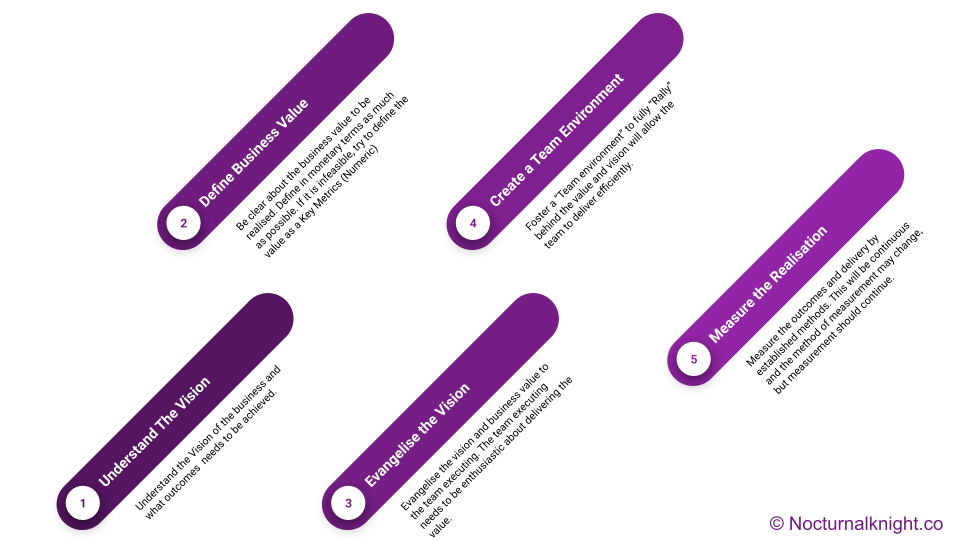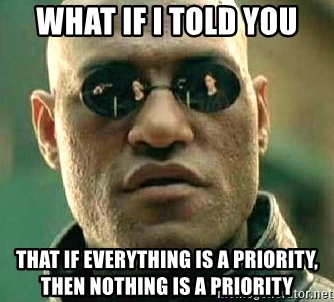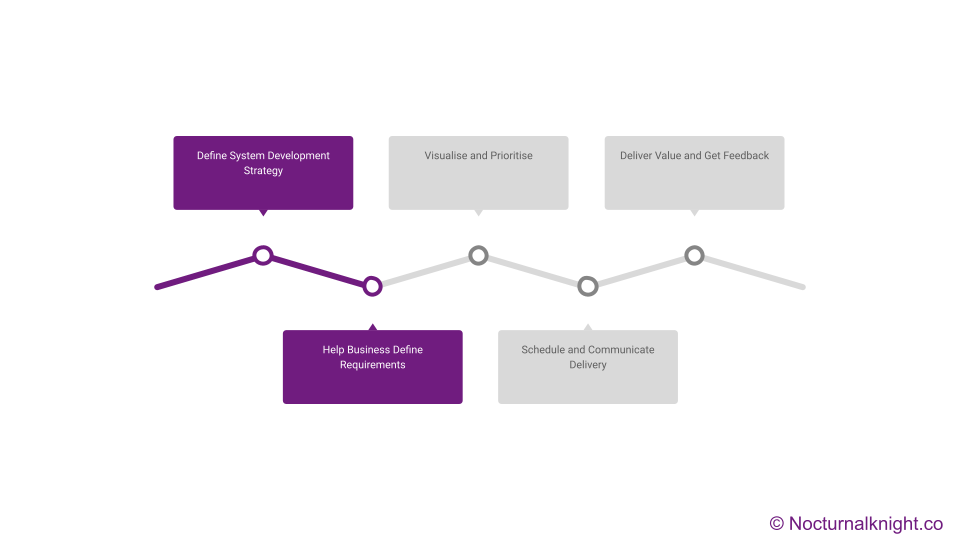Business Value Delivery by Engineering Teams in StartUps – Part 2
In this multi-part post, I will try to articulate my view on the importance of business value and its delivery by engineering teams. This is the second part, where I will share my perspective on the “How of it”.
Part 2: The How of it – Define, Visualise, Prioritise, Develop, Deliver & Measure.

1). Define Systems Development Strategy
The first thing a “Tech” Founder need to do is define the Systems Development Strategy. At a very high level, the systems development strategy should detail the state of the current/planned systems, the high-level business strategy for the next 2-5 years and maps out a plan to get there. An engineering leader will drive the creation and implementation of the development strategy to ensure the business can meet their current and future needs. Working closely with architects and technical leads, the engineering leader can formulate a solid development strategy.
The development strategy should detail the core architecture direction and technologies for the systems, including high-level plans for delivery. The development strategy is the crux of all efforts to deliver business value. Without a firm foundation of proper system architecture and technology, the business will have a difficult time delivering the value they need to survive.
If you’re an Engineering Leader who joined the startup after the MVP is created, it is your responsibility to understand the business strategy and formulate the Development Strategy as early as possible.
If your startup doesn’t have a solid development strategy or similar document, the following is a great place to start:
- Gather business needs: Gather high-level business needs/strategy to cater for the now and future (2-5 years) horizon. Not a deep dive, but deep enough to judge existing systems and measure other options. (Question like How many new new users will be added month-on-month, what is the order of magnitude of transactions we plan to rake, is it thousands or millions or tens of millions – Each will point you in a different direction on the system design)
- Review of existing systems: Analysis of current systems around fit for purpose and whether it can be maintained and extended to meet the future needs uncovered in the above. (The MVP may seem to work fine and it will be tempting to build “On-Top” of it with a plethora of “Features”, resist the urge and pressure, if applicable)
- Technologies / Architecture: Based on the review of the first two bullet points, you may recommend a strategic direction. The decision here could range from rebuilding the entire system with a new solution, to replacing components of the system with off the shelf/Open-source components. Alternatively, you may find the existing system is a strong foundation which needs modernising or scaling. In which case, the development strategy document would detail a range of architectural and technologies for future development.
The above is a good starting point and will allow the business to get started on implementing the development strategy. You may do it even before starting with the Startup and make it a Pre-Joining exercise with the Founders and Senior folks. At the end of this exercise, you will have performed an extensive analysis of the current systems and have a strategic direction for the systems.
2). Help the Business Define Requirements
It is essential to understand what needs to be delivered before you can go ahead and deliver the next Amazon or Airbnb. It has been my experience that on occasion, the business will need some “External Inputs” to finalise what is required.
When the business has a lot of ideas for improvements, they can sometimes get muddled together and lost. To counter this, we at ITILITE do a “Quarter Theme“. Before ITILITE I worked with Zarget, where we had a similar “Themed Quarterly Roadmaps” as well. This “Theming” helps in prioritising the focus areas. More on that in the next section
After which, we can visualise the entire scope of these ideas using User Story Maps. User story maps are visual representations of functionality requirements where all the requirements documented using a system of cards. It becomes a more straightforward (not easy) task to slice and dice these requirements using a story map to cull anything that is not critical to the business.
For the remaining requirements, we need to gather a little more information to progress to the next step, for each requirement we need to capture:
- Description: High-level description of the change. Not a HLD/LLD but enough to provide a high-level order of magnitude estimate.
- Business benefits: Here we are looking to understand what benefits we can expect from the business change.
- High-Level estimate: Order of magnitude level estimate, lots of refinement to still take place, however, gives us a good idea around sizing.
- Business SME and Sponsor: Details of people we can go to get more information.
The detail we capture for each of these changes is small, the reason being these items are a wish list only and not confirmed, so we do not want to waste more time on these then we need (lean thinking). While it is the domain of product managers and business analysts to flesh out business requirements and benefit statements, the engineering leader also plays an essential part in this process. Engineering leaders can use their experience to provide the high-level estimates for development, or indeed recommend ways to implement the requirement without the need to write additional code.
Another area where engineering leaders should influence is ensuring and non-functional (technical strategy items or technical debt) is included for development prioritisation. These technical plumbing is not attractive to the business but could be critical for the business to achieve their long term goals. Engineering leaders are the people that need to fight to ensure they are on the table.
Also, while you analyse requirements, where possible, try to group requirements where they affect the same code or system module. Grouping requirements will assist us in prioritisation, sequencing and hence the Go-To-Market, which is a key parameter for the business. The last thing we need to do is storing these requirements in our product backlog, to be reviewed and prioritised by the business in our next step.
3) Visualise the work and prioritise
In our third step, we are getting closer to the business deciding on their valuable items. Taking our list of requirements from our product backlog, we now present these to the business to discuss and rank in order of importance.
As discussed above, there will always be x+n “Projects” in the asks. Where “x” is the number of features you can effectively deliver in the timeline. And all “Projects” will look like they are P0 to solve.
If Everything Is a Priority, Then Nothing Is!

Having an extensive list of items to visualise enables the business to understand that we cannot have everything, and need to select the items that will make the most significant difference to their business (i.e., highest business value).
This is again, not because of intent, but because of trying to do “Too-Many” things and “Too-Soon”. Independently, all of the asks may sound truly important. Every Leader/Function within your Start-Up will come with several competing “Projects”. The Finance Team may want that flashy invoicing module or an ERP integration with your suppliers/customers, the Customer Success would want that Advanced Analytics platform integrated, The Support Teams may want that long-standing “Quirks” on the product ironed out. Left to Engineering, this is a sure recipe for disaster. This is where a Strong Product Leadership helps!
A business analyst or product manager typically runs these planning and prioritisation meetings. However, the engineering leader also has a place at the table to provide insight and assistance to the businesses decision-making process. Who from the business should attend these meetings? It is essential to gather a broad cross-section of business stakeholders for every Department or Function that uses the Product in question. We don’t want one department having too much influence that may not be of benefit to the business.
The meeting could have the following Agenda:
- Review items: The group will discuss each item in the (curated) product backlog in an open and honest discussion.
- Accept or reject: The item will be approved for development or rejected. Rejected items will have their requestor notified, to ensure they are in the loop.
- Ranking: Approved items get added to the backlog in priority order.
At ITILITE, We have the backlog/Thematic items in a Google Sheet, which is distributed at least a week before the meeting to ensure the Leaders have enough time to review, ask any questions before the meeting to ensure a smooth meeting. During the meeting, we view the sheet, top to bottom taking notes where required.
At the end of this meeting, we have something special. We have a prioritised list of business value and Key Outcomes.
The prioritisation meeting can be held quarterly or monthly, depending on the speed of change in your Start Up. We do it on a quarterly cycle to meet with the Leadership, so as not to overload these folks from actually getting their work done.
If the business has urgent changes which require attention, an emergency prioritisation session can be called-in where a meeting can occur to review and approve changes to the delivery schedule. Alignment should happen outside on one-on-ones and this meeting is a platform for other leaders to either ascent or dissent on the re-prioritisation.
4) Schedule and communicate delivery
In the fourth step, we now have a list that ranks all the business requirements in priority order. We now have confidence that the business indeed wants these work items completed and the order they prefer. The engineering team can now spend time working out how to deliver these items. Remembering from step two, we gathered very high-level requirements, (so not to waste time before they were endorsed), we now need to finish fleshing these items out enough to commence delivery.
There are a few mechanisms we can use to gather the information we need to get going, and the main one I like is the feature or project kickoff & inceptions. The kickoff is a process where we get the delivery team together to discuss the work that needs to be delivered. Inceptions can run anywhere up to a few weeks for big projects; it depends on how much time you allow here. During our inception, the delivery team all get on the same page with the requirements in question and can ask questions of each other or the sponsor to get all the information they need.
Technical delivery decisions can also be made, including creating simple prototypes to test out delivery options. Once the inception is complete, the delivery team have all their information, more confident delivery estimates are possible, sprint planning can take place, and the overall delivery schedule is known.
From here, the final step is the communication of the delivery schedule to all relevant stakeholders. Ensuring people can ask questions or point out any problems they see with this schedule.
5) Deliver value often get feedback
The final step here is to get the job done. The best way to deliver software is in small chunks completed during our sprints (typically two-week blocks). Sprints are the quickest way to deliver business value, allowing the business to gradually use this value much quicker than waiting for a monolithic release to occur.
At the end of each sprint, the team should be running product demo events. A product showcase allows the product and engineering teams to show off their excellent work to the business, who have an opportunity to provide their feedback on the product. This can start even before the first “releasable” product is out. It can start with mockups, design and prototypes. Then it will progress to V0, V1 and so forth. This feedback loop is another mechanism to ensure we are hitting the mark in terms of the delivery of business value.

Conclusion
I hope i was able to do justice to the process in this article. The key to delivering business value is having close relationships with the stakeholders, ensuring that they are involved in each step of the process. The business stakeholders are the only folks that can define business value. However, it is the role of engineering leaders to ensure proper technical oversight takes place to ensure the timely delivery of business value.

